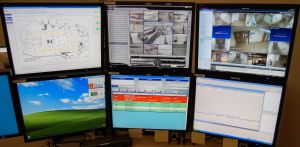| |
AOC Serves as Airport's Nerve Center
| click on photo to expand |
 |
Runway temperatures and video cameras are among many items monitored in
the operations center.
Photo by Jay Thompson |
(posted May 20)
The $11.9 million Airport Operations Center is the nerve center of the
six month old Indianapolis International Airport because "practically
everything is wired through here," according to Bob Spitler, Director
of Airport Security.
The AOC was designed with flexibility in mind to meet crisis situations.
The center can easily be activated into an Emergency Operations Center
if disaster strikes. "You have a building within a building,"
Spitler said, describing the interior room.
The EOC becomes a headquarters for the State Police, TSA, IMPD, the Mayor
and other government agencies. Every support agency has its own computer
and phone. The EOC's state of the art technology includes a white board
that can store notes and drawings written on it into files on a PC for
easy distribution.
The building is capable of withstanding an EF-4 tornado due to its one
foot thick poured concrete interior walls, ceiling and 2.5" thick,
triple dead bolt doors. Even the overhead doors for vehicle access can
withstand tornado force winds. "When everything else comes to an end
this place is still going to be standing."
Spitler said it made sense to build the state of the art building on an
open piece of ground rather than trying to improve the existing operations
center in the old UAL maintenance building.
Once a year, the airport conducts disaster exercises to prepare for emergency
situations. "You can never make a disaster situation a good thing,
but you can make it better than it would have been if you have never practiced."
Spitler credits the building design to Ratio Architects. Security cameras
monitor all areas of the airport, as well as sensors sending data about
the runways' temperatures. Each runway has three sensors. Spitler explained
snow removal crews need to know the runway temperature and wind direction
in order to determine whether to use dry chemicals or spray chemicals on
the runway. Different chemicals are effective at different temperatures.
Cost of the material used to treat runways has risen dramatically in recent
years. "We used to spend $10,000 to spray the runways and taxiways,
and now we spend $50,000."
The AOC receives all fire, police and 911 calls and serves as a backup
MECA public safety answering point. The AOC has sensors and alarms for
equipment that didn't exist in the old terminal, like sensors on the moving
walkways and escalators. A change in water pressure due to a water main
break set off the fire alarm in late December. If an airline's loading
bridge does not work, it contacts the AOC to dispatch maintenance operations.
The old airport terminal is monitored since a skeleton staff of 30 still
occupies the administrative building. The old terminal is now fenced for
increased security.
|
|